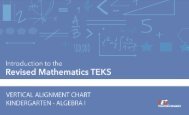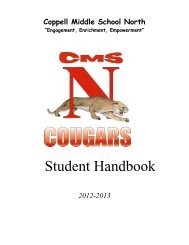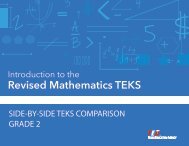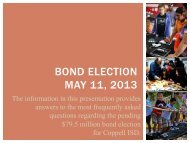Grade 3 – MathematicsCurrent <strong>TEKS</strong>: Probability and statistics Revised <strong>TEKS</strong> (2012) Supporting Information NotesThe phrase “where each picture or cell mightrepresent more than one piece of data” hasbeen restated as “with scaled intervals.”++3(13)(A) Probability and statistics. Thestudent solves problems by collecting,organizing, displaying, and interpreting setsof data.The student is expected to collect,organize, record, and display data inpictographs and bar graphs where eachpicture or cell might represent more thanone piece of data.3(13)(B) Probability and statistics. Thestudent solves problems by collecting,organizing, displaying, and interpreting setsof data.The student is expected to interpretinformation from pictographs and bargraphs.3(8)(A) Data analysis. The student appliesmathematical process standards to solveproblems by collecting, organizing, displaying,and interpreting data.The student is expected to summarize adata set with multiple categories using afrequency table, dot plot, pictograph, orbar graph with scaled intervals.3(8)(B) Data analysis. The student appliesmathematical process standards to solveproblems by collecting, organizing, displaying,and interpreting data.The student is expected to solve oneandtwo-step problems using categoricaldata represented with a frequency table,dot plot, pictograph, or bar graph withscaled intervals.A frequency table shows how often an item, anumber, or a range of numbers occurs. Talliesand counts are used to record frequencies.Students begin work with frequency tables ingrade 3.A dot plot may be used to representfrequencies. A number line may be used forcounts related to numbers. A line labeled withcategories may be used as well if the contextrequires. Dots are recorded vertically abovethe number line to indicate frequencies. Dotsmay represent one count or multiple counts ifso noted. Students begin work with dot plotsin grade 3.Students begin work with pictographs ingrade K and bar graphs in grade 1 with theRevised <strong>TEKS</strong> (2012).Specificity for the purpose of interpretinggraphs has been added with the phrase “solveone- and two-step problems.”Specificity has been added regarding the typeof data. Categorical data are the focus ingrade 3.Specificity regarding the graphicalrepresentations has been added with thephrase “with scaled intervals.”Students begin work with frequency tablesand dot plots in grade 3 with the Revised<strong>TEKS</strong> (2012).–3(13)(C) Probability and statistics. Thestudent solves problems by collecting,organizing, displaying, and interpreting setsof data.The student is expected to use data todescribe events as more likely than, lesslikely than, or equally likely as.The content of this SE was moved tograde 7:Proportionality7(6)(C)©2013 Texas Education Agency. All Rights Reserved 2013 Introduction to the Revised Mathematics <strong>TEKS</strong>: Side-by-Side <strong>TEKS</strong> Comparison Grade 18
Grade 3 – MathematicsCurrent <strong>TEKS</strong>: Underlying Processes andMathematical Tools3(14)(A) Underlying processes andmathematical tools. The student appliesGrade 3 mathematics to solve problemsconnected to everyday experiences and• activities in and outside of school.The student is expected to identify themathematics in everyday situations.3(14)(B) Underlying processes andmathematical tools. The student appliesGrade 3 mathematics to solve problemsconnected to everyday experiences andactivities in and outside of school.•The student is expected to solveproblems that incorporate understandingthe problem, making a plan, carrying outthe plan, and evaluating the solution forreasonableness.3(14)(C) Underlying processes andmathematical tools. The student appliesGrade 3 mathematics to solve problemsconnected to everyday experiences andactivities in and outside of school.•The student is expected to select ordevelop an appropriate problem-solvingplan or strategy including drawing apicture, looking for a pattern, systematicguessing and checking, acting it out,making a table, working a simplerproblem, or working backwards to solvea problem.Revised <strong>TEKS</strong> (2012) Supporting Information Notes3(1)(A) Mathematical process standards.The student uses mathematical processes toacquire and demonstrate mathematicalunderstanding.The student is expected to applymathematics to problems arising ineveryday life, society, and the workplace.3(1)(B) Mathematical process standards.The student uses mathematical processes toacquire and demonstrate mathematicalunderstanding.The student is expected to use aproblem-solving model that incorporatesanalyzing given information, formulatinga plan or strategy, determining asolution, justifying the solution, andevaluating the problem-solving processand the reasonableness of the solution.The focus has shifted to application.The opportunities for application have beenconsolidated into three areas: everyday life,society, and the workplace.This SE, when tagged to a content SE, allowsfor increased rigor through connectionsoutside the discipline.The revised SE restates and condenses3(14)(B) and 3(14)(C).Problem-Solving ModelRevised <strong>TEKS</strong>Current <strong>TEKS</strong>(2012)Understanding theproblemMaking a planCarrying out theplanEvaluating thesolution forreasonablenessAnalyzing giveninformationFormulating aplan or strategyDetermining asolutionJustifying thesolutionEvaluating theproblem-solvingprocess and thereasonablenessof the solution3(14)(D) Underlying processes andmathematical tools. The student appliesGrade 3 mathematics to solve problemsconnected to everyday experiences andactivities in and outside of school.•The student is expected to use tools suchas real objects, manipulatives, andtechnology to solve problems.3(1)(C) Mathematical process standards.The student uses mathematical processes toacquire and demonstrate mathematicalunderstanding.The student is expected to select tools,including real objects, manipulatives,paper and pencil, and technology asappropriate, and techniques, includingmental math, estimation, and numbersense as appropriate, to solve problems.The phrase “as appropriate” has beeninserted into the Revised <strong>TEKS</strong> (2012). Thisimplies that students are assessing which toolto apply rather than trying only one or all.“Paper and pencil” is now included in the listof tools that still includes real objects,manipulatives, and technology.©2013 Texas Education Agency. All Rights Reserved 2013 Introduction to the Revised Mathematics <strong>TEKS</strong>: Side-by-Side <strong>TEKS</strong> Comparison Grade 19
















